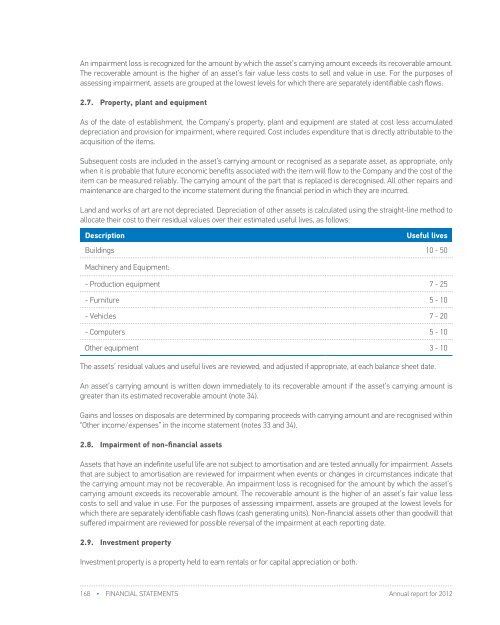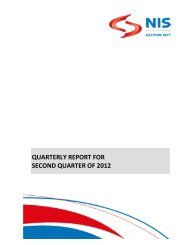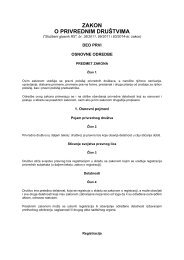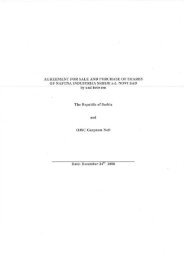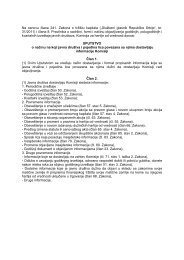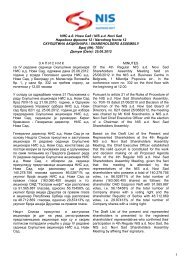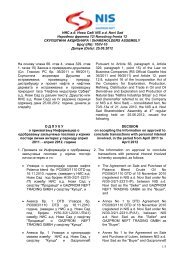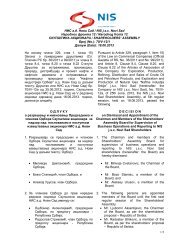FY 2012 - Investor Relations - NIS
FY 2012 - Investor Relations - NIS
FY 2012 - Investor Relations - NIS
You also want an ePaper? Increase the reach of your titles
YUMPU automatically turns print PDFs into web optimized ePapers that Google loves.
An impairment loss is recognized for the amount by which the asset’s carrying amount exceeds its recoverable amount.The recoverable amount is the higher of an asset’s fair value less costs to sell and value in use. For the purposes ofassessing impairment, assets are grouped at the lowest levels for which there are separately identifiable cash flows.2.7. Property, plant and equipmentAs of the date of establishment, the Company’s property, plant and equipment are stated at cost less accumulateddepreciation and provision for impairment, where required. Cost includes expenditure that is directly attributable to theacquisition of the items.Subsequent costs are included in the asset’s carrying amount or recognised as a separate asset, as appropriate, onlywhen it is probable that future economic benefits associated with the item will flow to the Company and the cost of theitem can be measured reliably. The carrying amount of the part that is replaced is derecognised. All other repairs andmaintenance are charged to the income statement during the financial period in which they are incurred.Land and works of art are not depreciated. Depreciation of other assets is calculated using the straight-line method toallocate their cost to their residual values over their estimated useful lives, as follows:DescriptionUseful livesBuildings 10 - 50Machinery and Equipment:- Production equipment 7 - 25- Furniture 5 - 10- Vehicles 7 - 20- Computers 5 - 10Other equipment 3 - 10The assets’ residual values and useful lives are reviewed, and adjusted if appropriate, at each balance sheet date.An asset’s carrying amount is written down immediately to its recoverable amount if the asset’s carrying amount isgreater than its estimated recoverable amount (note 34).Gains and losses on disposals are determined by comparing proceeds with carrying amount and are recognised within“Other income/expenses” in the income statement (notes 33 and 34).2.8. Impairment of non-financial assetsAssets that have an indefinite useful life are not subject to amortisation and are tested annually for impairment. Assetsthat are subject to amortisation are reviewed for impairment when events or changes in circumstances indicate thatthe carrying amount may not be recoverable. An impairment loss is recognised for the amount by which the asset’scarrying amount exceeds its recoverable amount. The recoverable amount is the higher of an asset’s fair value lesscosts to sell and value in use. For the purposes of assessing impairment, assets are grouped at the lowest levels forwhich there are separately identifiable cash flows (cash generating units). Non-financial assets other than goodwill thatsuffered impairment are reviewed for possible reversal of the impairment at each reporting date.2.9. Investment propertyInvestment property principally comprises petrol stations, business facilities and apartments rented out to current andformer Company employees for a period exceeding one year.Investment property is carried at fair value, representing open market value based on active market prices, adjusted, ifnecessary, for any difference in the nature, location or condition of the specific asset. Changes in fair values are recordedin the income statement as part of other income (expenses) (note 33 and 34).Subsequent expenditure is capitalized only when it is probable that future economic benefits associated with it will flowto the Company and the cost can be measured reliably. All other repairs and maintenance costs are expensed whenincurred. If an investment property becomes owner-occupied, it is reclassified to property, plant and equipment, and itscarrying amount at the date of reclassification becomes its deemed cost to be subsequently depreciated.2.10. Construction contractsA construction contract is defined by IAS 11 as a contract specifically negotiated for the construction of an asset.Contract costs are recognized as expenses in the period in which they are incurred.When the outcome of a construction contract cannot be estimated reliably, contract revenue is recognised only to theextent of contract costs incurred that are likely to be recoverable.When the outcome of a construction contract can be estimated reliably and it is probable that the contract will beprofitable, contract revenue is recognised over the period of the contract. When it is probable that total contract costswill exceed total contract revenue, the expected loss is recognised as an expense immediately.Variations in contract work, claims and incentive payments are included in contract revenue to the extent that mayhave been agreed with the customer and are capable of being reliably measured.The Company uses the ‘percentage-of-completion method’ to determine the appropriate amount to recognise in agiven period. The stage of completion is measured by reference to the contract costs incurred up to the reportingdate as a percentage of total estimated costs for each contract. Costs incurred in the year in connection with futureactivity on a contract are excluded from contract costs in determining the stage of completion. They are presented asinventories, pre-payments or other assets, depending on their nature.The Company presents as an asset the gross amount due from customers for contract work for all contracts inprogress for which costs incurred plus recognised profits (less recognised losses) exceed progress billings. Progressbillings not yet paid by customers and retention are included within ‘trade and other receivables’.The Company presents as a liability the gross amount due to customers for contract work for all contracts in progressfor which progress billings exceed costs incurred plus recognised profits (less recognised losses).2.11. Investments in subsidiariesInvestments in subsidiaries are measured using the cost method, whereby these investments are recognized atcost without any changes in the value of investments originating from results. If there are indications that the valueof investment has decreased at the reporting date, the assessment of the recoverable value of investment is beingperformed.If the recoverable value is less than the book value, the book value is reduced to its recoverable value and impairmentloss of investment is recognized as expense.Investment property is a property held to earn rentals or for capital appreciation or both.168 • FINANCIAL STATEMENTS Annual report for <strong>2012</strong>Annual report for <strong>2012</strong>FINANCIAL STATEMENTS • 169


